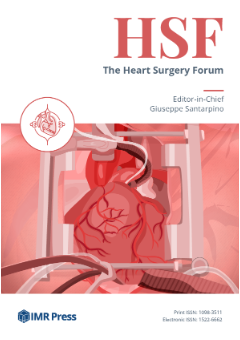Cite this article
1
Downloads
11
Citations
1
Views
Announcements
The Heart Surgery Forum (HSF) is published by IMR Press from Volume 28 Issue 9 (2025). Previous articles were published by another publisher under the CC-BY-NC licence, and they are hosted by IMR Press on imrpress.com as a courtesy and upon agreement.
Open Access
Article
Levosimendan Use Increases Cardiac Performance after Coronary Artery Bypass Grafting in End-Stage Renal Disease Patients
Hakan Atalay1, Zeki Temizturk2, Hasan Baki Altinsoy3, Davut Azboy2, Atakan Atalay4, Salih Colak5, Omer Faruk Dogan6
Show Less
Affiliation
1
Department of Cardiovascular Surgery, Private Mersin Middle-East Hospital, Mersin, Turkey
2
Department of Cardiovascular Surgery, The Health Sciences Universtiy, Elazığ Research and Training Center, Elazığ, Turkey
3
Department of Radiology, The Health and Sciences University, Tunceli Government Hospital, Tunceli, Turkey
4
Department of Cardiovascular Surgery, Çukurova University School of Medicine, Adana, Turkey
5
Instructor of Cardiology, The Health Sciences University, Adana Numune Research and Training Center, Adana, Turkey
6
Department of Cardiovascular Surgery, The Health Sciences Universtiy, Numune Research and Training Center Adana, Turkey
Heart Surg. Forum 2016, 19(5),
230–236;
https://doi.org/10.1532/hsf.1426
Published:
27 October 2016
Abstract
Background:The effect of levosimendan on myocardial performance has not been studied in dialysis-dependent end-stage renal disease patients who have undergone coronary artery bypass grafting (CABG) surgery. Our aim was to investigate the effect of levosimendan on postoperative hemodynamic effects in end-stage renal disease patients undergoing CABG operation.Methods:We performed 58 elective isolated CABG operations in end-stage renal disease patients. The study group received levosimendan at a slow bolus dose of 3 µg/kg, followed by a 24-hour infusion of 0.03-0.05 µg/kg/kg/min. (study group [SG]: n = 25). The remaining patients received a placebo (control group [CG]: n = 33). The mean left ventricular ejection fraction of both groups was similar (44.6 ± 55.4% versus 42.8 ± 53.9%). Hemodynamic data were collected at the end, at 1 hour after CPB, and thereafter at 6, 12, and 24 hours in the ICU. Preoperatively, at the end of the operation, at 1 hour after CPB, and thereafter at 6, 12, and 24 hours in the ICU, blood samples from the peripheral vein were collected for cardiac troponin-I (c-TnI) and lactate levels. Norepinephrine if needed started during the rewarming period in both groups.Results:One patient in SG (4%) and 4 patients (12.1%) in CG died postoperatively (P < .01). Cardiac output and cardiac index values did not change early after weaning from extracorporeal circulation, and they were nearly similar during the next 6 hours in both groups. In SG, cardiac output and cardiac index significantly improved at 6 hours, and were stable at the end of 24 hours (P < .001). Hemodynamic parameters were nearly similar after the operation, and did not change significantly at the end of 24 hours in CG. Hemodynamic improvement caused a significant reduction in systemic and pulmonary artery vascular resistance index in SG (P < .002). Pulmonary capillary wedge pressure decreased significantly in SG (P < .034). Cumulative inotrope dose requirement and intraaortic balloon pump use were significantly lower in SG. In addition, blood lactate and cTnI levels were significanly lower in SG (P < .044).Conclusion:No important adverse effect was detected during levosimendan infusion. Because levosimendan at a dose of 0.03-0.05 μg/kg/min increased myocardial performance significantly in the postoperative period, it can be used safely in end-stage renal disease patients undergoing isolated CABG. The requirement of vasopressors were lower in SG.

